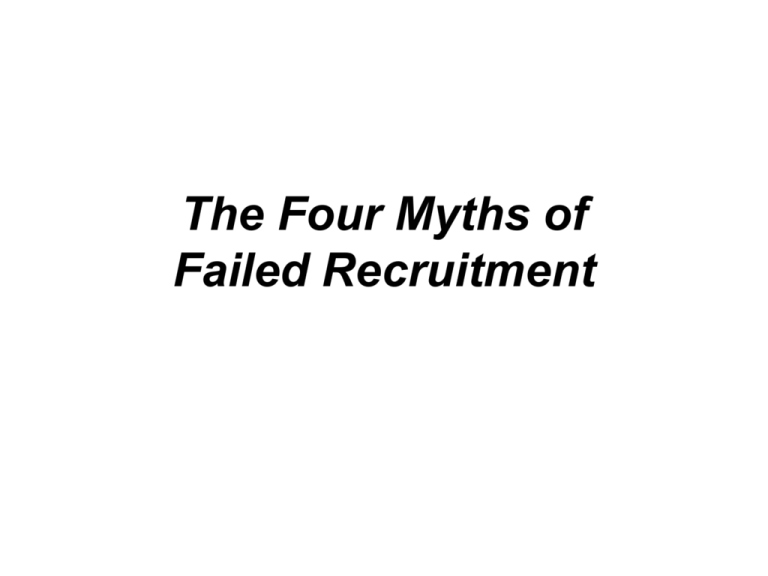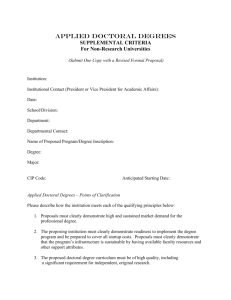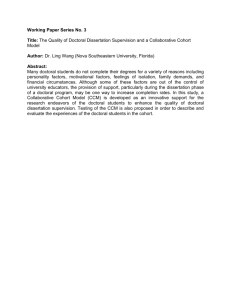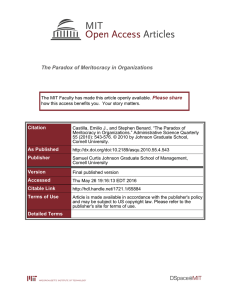Four Myths of Faculty Recruitment - Vice
advertisement

The Four Myths of Failed Recruitment The Leaky Pipeline • Diverse candidates are lost to the academy before they can become recruits resulting in a ‘limited pool’ • ‘…we have to keep going back to the still really unfortunate problem of the fact that only 2% of the Ph.D.s in the United States […] awarded annually are to African Americans, and that’s just a tiny number of people’ (Former president of Harvard, Neil Rudenstine). The Leaky Pipeline • Olivas (1994) – low graduation rates still provide a pool over time which is capable of altering current representation. • Trower & Chait (2002) – even in disciplines with a higher number of visible minority and women scholars (e.g. education & psychology), faculties continue to be predominantly white and male. Bidding Wars (High Demand/Low Supply) • ‘Although a concerted effort has been made, small candidate pools and intense competition between top universities has made growth in faculty numbers extremely difficult […] In disciplines such as engineering, mathematics and many hard sciences, the number of qualified candidates is extremely limited’ (Smith et al, 1996: 1) Bidding Wars (High Demand/Low Supply) • Smith et al (1996) – 393 recipients of Ford, Mellon and Spencer Fellowships • 6 mini-myths:– Myth: Scarcity causes competition – Reality: Only 11% of these scholars were ‘sought after’, the rest encountered difficulties and limitations in the job market – Myth: Scarcity in science causes high demand – Reality: Majority of scientists not pursued for jobs. Many concerned about finding jobs or had left academia because of an inability to find an academic job. Bidding Wars (High Demand/Low Supply) • Six mini-myths con’t. – Myth: Only go to prestigious institutions – Reality: A range of preferences affected decisions about institutions including geography, mobility & professional goals – Myth: Revolving door recruitment – Reality: Reasons for change focused on institutional difficulties, dual-career choices & appropriate fit rather than financial packages and prestige. Bidding Wars (High Demand/Low Supply) • Six myths con’t. – Myth: Heterosexual white males have no chance – Reality: Experiences for white men varied, 20% underutilised, 24% had good experience. White men who had expertise related to diversity had a significant advantage in the job market. Meritocracy • Meritocracy – objective standards of merit. • Caplan (1992) – traditional notions of excellence do not recognise diversity • Trower (2003) – ‘…quite simply, the academic playing field is not level. The “game” was invented before women and minorities were even allowed to play; they weren’t considered when those who ruled made the rules. And those rules, barely tweaked over the last century, are now so deeply entrenched in the culture of the academy as to be orthodoxy’ (p. 1). Meritocracy • Trower (2003), academic culture that:• ‘does not necessarily suit the needs, values, and beliefs of a new generation of scholars, women and men, majority and minority, and • advantages white males while it disadvantages women and persons of color, thereby making what appear to be “choices” made by women and minorities not really choices at all.’ Meritocracy • Sonnert & Holton (1996) research on NSF postdoc fellowships:– Men published 2.8 papers per year while women published 2.3. – Women’s articles were cited more frequently (24.4 versus 14.4) – Women’s writing more noteworthy? • Wenneras & Wold (1997) research on post-doc fellowship applicants found that women had to publish approximately twice as much as men to achieve same success rate. Meritocracy • ‘The general principle, that diversity is a stronger basis for the advance of scientific knowledge than homogeneity, is supported by strong academic as well as social, arguments. To keep pace with the complexity of modern science and rapid discipline transfer of concepts, academic research groups must incorporate as wide as possible a range of problem solving and thinking styles. In order to teach effectively to potential scientists as well as to non-specialists, academic departments must welcome a range of communication styles and evaluation approaches. […] We have a responsibility, in the decade to come, to respond to these needs in the Canadian university system.’ Signed by the five NSERC Industrial Chairs for Women in Science and Engineering. Lesser Qualifications • Candidates from under-represented groups are ‘less qualified’ than others. • Smith et al (2004) examined doctoral granting institutions of visible minority faculty members • Used Carnegie classifications – Research I, Research II, Doctoral I, Doctoral II • No differences apparent. Lesser Qualifications Doctoral Granting Institutions of Visible Minority Faculty (Smith et al, 2004). Research Research Doctoral University University University II I I African American 94% Latino 75% American Indian 67% Asian American 90% 1% White 89% 1% Doctoral University II Non-US Degree Other Final Degree 4% 7% 7% 6% 7% 33% 1% 2% 6% 1% 1% 7% 1% Lesser Qualifications Faculty Hire by Rank (Smith et al, 2004). Professor Associate Professor Assistant Professor African American 23% 14% 64% Latino 27% 12% 61% American Indian 17% 17% 67% Asian American 14% 11% 75% White 23% 11% 64%







